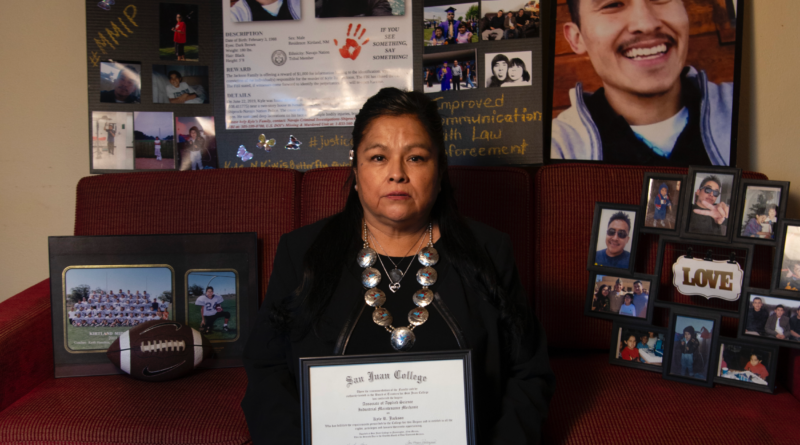Kyle Jackson Shot and Killed in Nenahnezad New Mexico
On the evening of June 22, 2019, the life of twenty-year Navajo community member Kyle Jackson was cut short on a dirt road just outside Nenahnezad, New Mexico. His death forced a grieving mother, extended family, and an entire community to grapple with grief, unanswered questions, and frustration over systemic barriers in investigating crimes on tribal lands. In the years since, his mother, Colleen Harrison Jackson, has become a tireless advocate for justice—not only for her son but for all Indigenous victims whose cases languish amid jurisdictional confusion and chronic underfunding. This article traces Kyle’s life, the circumstances surrounding his homicide, the investigative efforts and obstacles, and the ongoing ripple effects felt across the Navajo Nation and beyond.
Kyle Jackson’s Early Life and Aspirations
Born on February 3, 1988, in a modest home near Nenahnezad, Kyle Ray Jackson was the second of four children. Raised by his mother, Colleen, and supported by a tight-knit extended family, Kyle grew up immersed in Diné (Navajo) traditions. From a young age, he demonstrated a keen intellect and a deep curiosity about his heritage. He participated eagerly in community ceremonies, learned to speak Diné Bizaad at home, and spent summers helping his grandparents tend sheep and weave blankets.
Kyle excelled academically at Nenahnezad Community School, where teachers recognized him as both studious and compassionate. He captained the basketball team during his high-school years and volunteered at the local chapter house, helping elders navigate health-care paperwork. His dream was to return to the Navajo Nation after college and serve in tribal administration, working to improve infrastructure and educational opportunities for families like his own. In 2009, Kyle earned a scholarship to attend the University of New Mexico, where he pursued a degree in Indigenous Studies with a focus on community development.
Graduating in the spring of 2013, Kyle returned to Nenahnezad armed with enthusiasm and fresh ideas. He spent several years working as a youth counselor at the local Boys & Girls Club, mentoring at-risk teens and organizing cultural workshops. His college diploma—propped on a shelf at his mother’s home—served as a symbol of possibility, not only for him but for younger cousins who saw in Kyle a role model who had walked both the reservation and the university campus.
Life on the Navajo Nation and Community Connections
Despite opportunities that took him away briefly, Kyle always considered Nenahnezad home. In 2018, he accepted a position at a nearby tribal office, working on grant writing for rural development projects. He spent weekdays traveling the dirt roads between chapter houses, meeting elders, and drafting proposals to improve road maintenance, water access, and broadband connectivity. His colleagues remember him as diligent, respectful, and eager to bridge the gap between traditional lifeways and modern resources.
Outside his professional life, Kyle was a fixture at family gatherings. He delighted younger cousins with his basketball skills and taught them the fundamentals of entrepreneurship—encouraging them to sell handmade jewelry or traditional crafts at local markets. He enjoyed riding his dirt bike along washes on weekends and occasionally visited friends in neighboring communities such as Upper Fruitland and Shiprock. Though the region suffered from economic hardship and limited infrastructure, Kyle’s presence radiated optimism: he believed that incremental improvements—better roads, reliable electricity, expanded internet—could transform lives.
Friends recall how Kyle kept meticulous journals, recording community needs, sketching drainage-ditch designs, and proposing solar-panel installations for chapter houses. He joined the local chapter council as a volunteer adviser in early 2019, hoping to learn the intricacies of tribal governance. As summer approached that year, Kyle’s schedule brimmed with meetings, family events, and plans for a mid-July barbecue to celebrate his sister’s high-school graduation. Yet fate intervened before any of those plans could come to fruition.
The Night of June 22, 2019
On Saturday, June 22, 2019, Kyle left his home in Nenahnezad just after 8:00 PM, saying he was going to meet a friend to discuss improvements for the local chapter house’s water system. His mother recalled that he was excited: “He said he had a new lead on a grant that could fund repairs.” He climbed into his dark blue pickup truck, waved goodbye, and drove out onto the sandy stretch of Reuben Benally Road. According to cell-phone records later obtained by investigators, his phone pinged near the north end of the community at 8:17 PM, then again near a seldom-travelled dirt track a mile farther west at 8:22 PM.
Shortly after, a passing motorist spotted Kyle’s truck parked at an odd angle near the roadside, headlights still on, engine running. Concerned, the motorist approached cautiously, expecting to find a flat tire or a mechanical breakdown. Instead, she saw Kyle slumped over in the driver’s seat, motionless, with a single gunshot wound to his chest. The motorist dialed 911, and local volunteer firefighters and tribal police arrived within twenty minutes. By then, Kyle was already deceased. No witnesses came forward at the scene, and no weapon was found nearby.
Discovery of the Body and Initial Reaction
When first responders reached the scene around 8:45 PM, they found Kyle’s truck idling, door ajar, and his body partially slumped forward on the steering wheel. The passenger window had been left rolled down, though it was unclear whether that was due to a struggle or simply a habit on a warm summer evening. Tribal police cordoned off the area, treating it as a likely homicide, and notified the FBI, as required under the 1978 Tribal Law and Order Act for major crimes on the reservation.
Word of Kyle’s death spread quickly through Nenahnezad. By 10:00 PM, relatives had gathered at his mother’s house, inconsolable in shared grief. Community leaders organized a prayer vigil at the chapter house, draping red cloth and lighting candles in his memory. Through the night, family members and neighbors offered tobacco and sage at prayer circles, asking for protection over Kyle’s spirit and guidance for investigators.
Law Enforcement and Jurisdictional Complexities
Investigating violent crime on the Navajo Nation involves a complex interplay between tribal law enforcement, the FBI, and state authorities. Under the Major Crimes Act, any murder on tribal land falls under federal jurisdiction, with the FBI taking a lead role. Local Navajo Nation Police (NNPD) officers typically secure the scene, collect initial evidence, and interview witnesses before turning the case over to federal agents. However, resource constraints—such as understaffed tribal police precincts, vast territories with limited road access, and language barriers—often hinder early investigative steps.
In Kyle’s case, the Nenahnezad Chapter House lacked a permanent police substation; the nearest NNPD office was located over thirty miles away in Shiprock. When tribal officers arrived at the scene, they documented photographs of the truck’s interior, collected clothing fibers, and secured Kyle’s phone. But the remoteness of the dirt road and absence of nearby surveillance cameras meant that potential witnesses might have driven by without seeing anything significant. Moreover, the gravel surface of Reuben Benally Road retained little in the way of footprints or tire marks after just a few hours of passing traffic.
By midnight, the FBI’s Farmington Resident Agency had sent agents to the scene to perform a forensic overview. Agents dusted for fingerprints, recorded blood-spatter patterns, and collected shell casings from the truck’s passenger footwell. Expert crime-scene technicians did their best to preserve trace evidence, but summer heat and sporadic rainfall in the preceding days had smudged potential footprints. Compounding matters, Kyle’s truck had remained running for twenty minutes before the engine was finally shut off, potentially blowing away scent dogs’ trails and disrupting any latent prints inside the cab.
The FBI Investigation and Closure
Over the next several months, the FBI conducted interviews with family members, friends, and acquaintances. They discovered that Kyle had been working late on grant proposals, meeting periodically with a young community organizer named Dustin Yazzie, who told investigators he had left Kyle at the roadside around 8:15 PM. Dustin said he drove away after offering to drop Kyle at his home, claiming Kyle waved him on. No one else admitted to seeing Kyle that night.
Despite reviewing call logs, text messages, and bank statements, the FBI found no clear motive—no sign of drug debts, no known threats, and no open conflicts with neighbors. They tested the shell casings and determined the firearm used was a .45-caliber semi-automatic pistol. Ballistic matches to any registered weapon in the region yielded no results, suggesting the killer used an unregistered or stolen firearm.
By late 2020, investigators had exhausted many leads. They offered a reward for information, distributed posters across reservation communities, and held a press briefing at the Shiprock FBI office. Yet tips remained scarce. In February 2021, agents officially closed the homicide file for lack of new evidence, marking it “inactive cold.” Case agents provided Colleen with a case number and the promise that any new credible information would reopen the investigation. But no substantive breakthroughs emerged.
The Impact on Family: Colleen Harrison Jackson’s Quest
From the moment she learned of her son’s death, Colleen immersed herself in every available resource. In the days immediately following June 22, she traveled to Albuquerque to meet FBI agents, demanding updates and insisting they leave no stone unturned. She combed through scattered evidence, hiring a private investigator for brief periods when family finances allowed. When federal authorities closed Kyle’s file, she refused to accept that closure as final.
Colleen’s home became a shrine to Kyle’s memory: his college diploma framed on the wall, shelves lined with photos of him smiling at family gatherings, and personal mementos such as beaded bracelets he made for his nieces. She spread copies of his high-school yearbook across the living-room table, hoping someone would recognize an expression in his eyes that might yield a clue. Each morning, she prayed in the traditional Diné way, offering cedar, corn pollen, and water, asking for guidance and healing for her family.
Over the ensuing years, Colleen attended tribal council meetings in Window Rock, met with members of the New Mexico Legislature in Santa Fe, and participated in Listening Sessions convened by the Department of Justice. She became an outspoken advocate for families of Missing and Murdered Indigenous Relatives (MMIR), speaking at rallies wearing a simple necklace bearing Kyle’s initials. Her voice—both tender with sorrow and steadfast with determination—echoed at candlelight vigils, community forums, and social-media live streams. Each time she spoke, she reminded listeners that her son was more than a case file: he was a beloved brother, a dedicated son, and a friend to countless youth across the reservation.
Community Response and Advocacy Efforts
Kyle’s murder reverberated far beyond Nenahnezad. Local schools held prayer services and launched awareness campaigns about youth violence and the importance of reporting suspicious activity. The Boys & Girls Club where Kyle once mentored youth renamed its conference room “The Kyle Jackson Learning Center” in his honor. Nearby chapters collaborated to host basketball tournaments raising funds for a headstone.
Meanwhile, community organizers such as Vangie Randall of Crusaders of Justice’s Northwest Sub-Chapter began collecting information on other unsolved homicides and disappearances. They distributed posters featuring Kyle’s smiling face and urged residents to call an anonymous tip line. In February 2023, family and friends gathered at Ojo Amarillo Church for a candlelight vigil marking what would have been Kyle’s thirty-fifth birthday—serving his favorite buttercream cake and collecting donations toward a proper headstone. At that vigil, speakers including tribal elders and state lawmakers pledged to press for increased funding for cold-case units serving Indigenous communities.
Despite these collective efforts, many relatives of other victims—like Kyle—found themselves disillusioned by the slow pace of progress. In public forums, they described how distrust in law enforcement grew each time a case went unanswered. Volunteers with grassroots organizations set up a makeshift “cold-case wall” at community events, displaying case summaries. Families shared phone numbers of tribal and FBI liaisons, urging others to demand accountability.
Broader Context: The Indigenous Homicide Crisis
Kyle’s case is far from isolated. Data compiled by advocacy groups indicate that Native Americans experience homicide rates more than twice the national average—and in rural areas of the Southwest, rates can soar even higher. Yet law-enforcement resources on tribal lands remain chronically underfunded. The Navajo Nation, sprawling across over 27,000 square miles, boasts only a handful of fully equipped police substations; some residents must drive more than fifty miles to file a missing person’s report. Jurisdictional gaps—where tribal police, state authorities, and the FBI share or, at times, abdicate responsibility—often lead to investigative delays.
These structural challenges compound obstacles such as language differences, cultural misunderstandings, and a pervasive fear of retaliation. Many families hesitate to speak up when suspects might be relatives or community members, fearing social ostracism. Meanwhile, forensic labs serving New Mexico reserves backlog evidence from multiple cases, resulting in delays of months—or even years—before DNA results or firearm matches are returned.
Kyle’s mother joined dozens of other advocates at the national level, calling on Congress to pass the “Savanna’s Act” and “Not Invisible Act,” legislation aimed at improving coordination among law enforcement agencies, increasing funding for victim-support services, and mandating data collection on missing and murdered Indigenous people. While these laws represent steps forward, grassroots activists emphasize that without robust implementation, they risk becoming symbolic gestures with limited real-world impact.
Ongoing Unanswered Questions
More than five years after Kyle’s death, key questions remain unanswered: Who drove that .45-caliber pistol? What motive led to his being shot on a quiet Saturday night? Did a fleeting conversation with a friend escalate into violence, or was it a random act? Investigators never identified any suspects publicly, and no one has been charged.
Friends who spoke privately to investigators disclosed that Kyle had recently expressed concerns about threats from an acquaintance over a late payment on borrowed money. However, forensic teams found no definitive evidence linking that individual to the scene. Some community members believed that the shooter may have fled south toward Albuquerque after the shooting, but no reliable witness saw the perpetrator’s vehicle. The absence of surveillance cameras on rural reservation roads means that any possible video evidence likely does not exist.
Colleen Jackson clings to the hope that someone—anyone—will come forward. She has posted flyers at grocery stores, chapter houses, and gas stations, offering a reward for information leading to an arrest. She fields phone calls from tipsters who sometimes claim to have heard rumors, but every lead either lacks credibility or amounts to rumors circulating around tribal council meetings. In the absence of confirmed breakthroughs, she continues to travel to the FBI’s Farmington office biannually, demanding updates on forensic testing and reminding agents that Kyle’s case is not just another statistic—it is personal.
Path Forward: Calls for Reform
Kyle’s case underscores the urgent need for systemic reform in how Indigenous homicides are investigated and resolved. Advocates propose several measures:
- Enhanced Tribal-Federal Partnerships: Formalized agreements ensuring Navajo Nation Police maintain access to federal databases and forensic labs without delay, coupled with joint training on evidence collection that respects cultural practices.
- Expansion of Cold-Case Units: Dedicated cold-case investigators embedded within tribal police departments, funded through federal grants, to revisit unsolved murders with fresh perspectives and modern forensic tools.
- Community-Based Tip Networks: Establishing trusted local liaisons—often elders or cultural advisors—who can collect tips from community members fearful of reporting to formal authorities, thus bridging the gap between informal knowledge and official investigations.
- Improved Victim Support Services: Providing families immediate counseling, legal advocacy, and financial assistance to navigate complex jurisdictional procedures without bearing all costs personally.
- Data-Collection Transparency: Mandating that all law-enforcement agencies report statistics on Indigenous homicides, missing persons, and case-closure rates to a centralized national repository, enabling policymakers to track progress and allocate resources more effectively.
Several state legislators in New Mexico introduced bills in early 2024 to funnel additional funds to tribal jurisdictions for forensic equipment, offering competitive grants to encourage collaboration among neighboring tribes. Nonprofit groups led by people like Vangie Randall hold annual workshops on community safety, teaching residents how to document evidence, preserve digital communication, and negotiate with law enforcement. While these efforts represent glimmers of hope, entrenched challenges in budgets, logistics, and cultural sensitivity persist.
Remembering Kyle and Demanding Change
On quiet evenings in Nenahnezad, candles flicker outside the Jackson home—tokens of remembrance for a son who dreamed of lifting up his community. At gatherings of Missing and Murdered Indigenous Relatives, his photograph, diploma, and a pair of well-worn basketball shoes sit side by side, symbolizing a life brimming with potential, truncated far too soon. As family members share prayers in Diné Bizaad, they invoke chants for healing and perseverance, ensuring Kyle’s spirit remains woven into traditional stories passed down to younger generations.
Yet remembrance alone cannot bring him back. Each year, Colleen Harrison Jackson marks the anniversary of June 22 with a small ceremony at Reuben Benally Road, offering cornmeal at the spot where her son’s life ended. She reads aloud passages from his journals—notes about community-center renovations, hopes for a scholarship fund in his name, and dreams of witnessing his nephews graduate. She turns those pages to family and friends, hoping that someone, somewhere, will recognize a clue that leads to justice.
In the broader narrative of Indigenous communities across the United States, Kyle’s story highlights systemic failures: the labyrinth of jurisdictional boundaries, the scarcity of forensic resources, and the cultural chasms that discourage victims’ families from engaging fully with law enforcement. It also illuminates the resilience of Diné traditions—prayers, gatherings, and collective healing—that sustain families long after investigators close their files.
As calls for reform echo through the halls of state capitols and tribal council chambers, the memory of Kyle Jackson serves as both a beacon of possibility and a stark reminder of loss. On the Navajo Nation, his name has become synonymous with perseverance: a testament to what one family’s unwavering advocacy can achieve, and a call to action for policymakers, law enforcement, and community members alike. Until someone steps forward with definitive information, Kyle will remain more than a murder statistic—he will live on in every prayer circle, policy meeting, and family gathering determined to ensure that Indigenous lives matter and that no mother must search six years for answers that should never have been withheld.
Discover more from City Towner
Subscribe to get the latest posts sent to your email.




